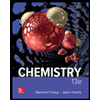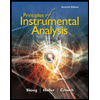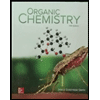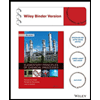
GENERAL,ORGANIC,+BIOCHEMISTRY-ALEKS 360
10th Edition
ISBN: 9781260994148
Author: Denniston
Publisher: MCGRAW-HILL HIGHER EDUCATION
expand_more
expand_more
format_list_bulleted
Question
Chapter 6.3, Problem 6.6PP
Interpretation Introduction
Interpretation:
The molarity of
Concept Introduction:
Number of mols can be calculated as follows,
Number of mols
Molarity
Expert Solution & Answer
Want to see the full answer?
Check out a sample textbook solution
Students have asked these similar questions
draw the major product formed with the listed reagents
Propose Williamson ether syntheses for the following compounds
Identify all functional groups
Chapter 6 Solutions
GENERAL,ORGANIC,+BIOCHEMISTRY-ALEKS 360
Ch. 6.1 - Describe how you would distinguish experimentally...Ch. 6.1 - Prob. 6.2QCh. 6.1 - Explain why, over time, a bottle of soft drink...Ch. 6.1 - Prob. 6.4QCh. 6.1 - Prob. 6.5QCh. 6.1 - Prob. 6.6QCh. 6.2 - Calculate the % (m/V) of 0.0600 L of solution...Ch. 6.2 - Prob. 6.2PPCh. 6.2 - Prob. 6.3PPCh. 6.2 - Prob. 6.4PP
Ch. 6.3 - Prob. 6.5PPCh. 6.3 - Prob. 6.6PPCh. 6.3 - Prob. 6.7PPCh. 6.3 - Prob. 6.7QCh. 6.3 - Prob. 6.8QCh. 6.3 - Prob. 6.8PPCh. 6.3 - Prob. 6.9PPCh. 6.4 - Prob. 6.9QCh. 6.4 - Comparing pure water and a 0.10 m glucose...Ch. 6.4 - Prob. 6.10PPCh. 6.4 - Prob. 6.11PPCh. 6.4 - Prob. 6.12PPCh. 6.4 - Prob. 6.13PPCh. 6.4 - Prob. 6.11QCh. 6.4 - Prob. 6.12QCh. 6.5 - Prob. 6.14PPCh. 6.5 - Prob. 6.15PPCh. 6.5 - Prob. 6.16PPCh. 6.5 - Prob. 6.13QCh. 6.5 - Prob. 6.14QCh. 6 - Prob. 6.15QPCh. 6 - Prob. 6.16QPCh. 6 - Which of the following solute(s) would form an...Ch. 6 - Prob. 6.18QPCh. 6 - Prob. 6.19QPCh. 6 - Prob. 6.20QPCh. 6 - Prob. 6.21QPCh. 6 - Prob. 6.22QPCh. 6 - Prob. 6.23QPCh. 6 - Prob. 6.24QPCh. 6 - Prob. 6.25QPCh. 6 - Prob. 6.26QPCh. 6 - Prob. 6.27QPCh. 6 - Prob. 6.28QPCh. 6 - The Henry’s law constant, k, for O2 in aqueous...Ch. 6 - The Henry’s law constant, k, for N2 in aqueous...Ch. 6 - Calculate the composition of each of the following...Ch. 6 - Calculate the composition of each of the following...Ch. 6 - Calculate the composition of each of the following...Ch. 6 - Calculate the composition of each of the following...Ch. 6 - Prob. 6.35QPCh. 6 - Calculate the composition of each of the following...Ch. 6 - Prob. 6.37QPCh. 6 - Prob. 6.38QPCh. 6 - Prob. 6.39QPCh. 6 - Prob. 6.40QPCh. 6 - Prob. 6.41QPCh. 6 - Prob. 6.42QPCh. 6 - Prob. 6.43QPCh. 6 - Prob. 6.44QPCh. 6 - Which solution is more concentrated: a 0.04% (m/m)...Ch. 6 - Which solution is more concentrated: a 20 ppt...Ch. 6 - Prob. 6.47QPCh. 6 - Prob. 6.48QPCh. 6 - Prob. 6.49QPCh. 6 - Prob. 6.50QPCh. 6 - Why is it often necessary to dilute solutions in...Ch. 6 - Write the dilution expression and define each...Ch. 6 - Prob. 6.53QPCh. 6 - Prob. 6.54QPCh. 6 - Prob. 6.55QPCh. 6 - Prob. 6.56QPCh. 6 - Calculate the volume of a 0.500 M sucrose solution...Ch. 6 - Calculate the volume of a 1.00 × 10−2 M KOH...Ch. 6 - It is desired to prepare 0.500 L of a 0.100 M...Ch. 6 - A 50.0-mL sample of a 0.250 M sucrose solution was...Ch. 6 - A 50.0-mL portion of a stock solution was diluted...Ch. 6 - Prob. 6.62QPCh. 6 - Prob. 6.63QPCh. 6 - Prob. 6.64QPCh. 6 - Prob. 6.65QPCh. 6 - Prob. 6.66QPCh. 6 - Prob. 6.67QPCh. 6 - Prob. 6.68QPCh. 6 - Prob. 6.69QPCh. 6 - Prob. 6.70QPCh. 6 - Prob. 6.71QPCh. 6 - Prob. 6.72QPCh. 6 - Prob. 6.73QPCh. 6 - Prob. 6.74QPCh. 6 - Prob. 6.75QPCh. 6 - Prob. 6.76QPCh. 6 - Prob. 6.77QPCh. 6 - Prob. 6.78QPCh. 6 - Answer Questions 6.79–6.82 based on the following...Ch. 6 - Answer Questions 6.79–6.82 based on the following...Ch. 6 - Answer Questions 6.79–6.82 based on the following...Ch. 6 - Answer Questions 6.79–6.82 based on the following...Ch. 6 - Prob. 6.83QPCh. 6 - Prob. 6.84QPCh. 6 - Prob. 6.85QPCh. 6 - Prob. 6.86QPCh. 6 - Prob. 6.87QPCh. 6 - Prob. 6.88QPCh. 6 - Prob. 6.89QPCh. 6 - Prob. 6.90QPCh. 6 - Prob. 6.91QPCh. 6 - Prob. 6.92QPCh. 6 - Prob. 6.93QPCh. 6 - Prob. 6.94QPCh. 6 - Prob. 6.95QPCh. 6 - Name the two most important cations in biological...Ch. 6 - Prob. 6.97QPCh. 6 - Explain why a dialysis solution must have an...Ch. 6 - Prob. 6.99QPCh. 6 - Prob. 6.100QPCh. 6 - Prob. 6.101QPCh. 6 - Prob. 6.102QPCh. 6 - Prob. 6.103QPCh. 6 - What type of solute dissolves readily in benzene...Ch. 6 - Prob. 6.105QPCh. 6 - Prob. 6.106QPCh. 6 - Prob. 6.107QPCh. 6 - Prob. 6.108QPCh. 6 - Prob. 6.109QPCh. 6 - Prob. 6.110QPCh. 6 - Prob. 6.111QPCh. 6 - Prob. 6.112QPCh. 6 - Prob. 6.113QPCh. 6 - Prob. 6.114QPCh. 6 - Prob. 1MCPCh. 6 - Prob. 2MCPCh. 6 - Prob. 3MCPCh. 6 - Prob. 4MCPCh. 6 - Prob. 5MCPCh. 6 - Prob. 6MCPCh. 6 - Prob. 7MCPCh. 6 - Prob. 8MCPCh. 6 - Prob. 9MCPCh. 6 - Prob. 10MCP
Knowledge Booster
Similar questions
- A mixture of CaCO3 and MgC2O4 of unknown mass was heated in a 0.5 L closed rigid vessel to 900 degrees C.at 400C the following reaction occurs:MgC2O4 -> MgO (s) + CO (g) + CO2 (g)At 700C a second reaction occurs: CaCO3 -> CaO (s) + CO2 (g)The solid mass in the vessel was measured to be 3.06 g at 400C and 2.03g at 900CQuestion: What is the partial pressure of CO in both temperatures? (400 and 900C), provide detailed explanation.arrow_forwardFor the following alkyne, complete the reaction sequentially (that is draw the intermediate that we can’t stop at) and then name (complete name) all 3 molecules.arrow_forwardGiven the reaction sequence below, answer the following. A. Provide the structure for A. B. Provide the structure for B (pay attention to stereochemistry). C. Provide the structure for C. D. What are the stereochemical designations for I and II (R/S)?arrow_forward
- There are 2 reactions (that you know of) to achieve the following transformation: One reaction is favored over the other because it avoids a competing reaction. A. Draw the favored reaction scheme (not the mechanism), be sure to include all necessary reagents. B. Draw the reaction scheme that is not favored and include all the possible products.arrow_forwardBoth carbocations and carbon-radicals have trigonal planar geometry. True or Falsearrow_forwardTeflon (polytetrafluoroethene) is prepared via the radial polymerization of tetrafluoroethene. What other reaction conditions (reagent, etc.) are needed to accomplish this? A. NBS, Light B. Heat, Cl2 C. Peroxide, Heat D. H2SO4, H2O, Heatarrow_forward
- Which of the following compounds can be reacted with ethene to prepare 1,1- dichlorocyclopropane? A. CCl4 B. CCl2 C. CHCl3 D. CH2Cl2arrow_forwardusing any reactions, starting with propene, propose a synthesis for the following moleculearrow_forwardFor a free radical bromination reaction, the stereochemistry of the product is easily controlled True OR Falsearrow_forward
arrow_back_ios
SEE MORE QUESTIONS
arrow_forward_ios
Recommended textbooks for you
 ChemistryChemistryISBN:9781305957404Author:Steven S. Zumdahl, Susan A. Zumdahl, Donald J. DeCostePublisher:Cengage Learning
ChemistryChemistryISBN:9781305957404Author:Steven S. Zumdahl, Susan A. Zumdahl, Donald J. DeCostePublisher:Cengage Learning ChemistryChemistryISBN:9781259911156Author:Raymond Chang Dr., Jason Overby ProfessorPublisher:McGraw-Hill Education
ChemistryChemistryISBN:9781259911156Author:Raymond Chang Dr., Jason Overby ProfessorPublisher:McGraw-Hill Education Principles of Instrumental AnalysisChemistryISBN:9781305577213Author:Douglas A. Skoog, F. James Holler, Stanley R. CrouchPublisher:Cengage Learning
Principles of Instrumental AnalysisChemistryISBN:9781305577213Author:Douglas A. Skoog, F. James Holler, Stanley R. CrouchPublisher:Cengage Learning Organic ChemistryChemistryISBN:9780078021558Author:Janice Gorzynski Smith Dr.Publisher:McGraw-Hill Education
Organic ChemistryChemistryISBN:9780078021558Author:Janice Gorzynski Smith Dr.Publisher:McGraw-Hill Education Chemistry: Principles and ReactionsChemistryISBN:9781305079373Author:William L. Masterton, Cecile N. HurleyPublisher:Cengage Learning
Chemistry: Principles and ReactionsChemistryISBN:9781305079373Author:William L. Masterton, Cecile N. HurleyPublisher:Cengage Learning Elementary Principles of Chemical Processes, Bind...ChemistryISBN:9781118431221Author:Richard M. Felder, Ronald W. Rousseau, Lisa G. BullardPublisher:WILEY
Elementary Principles of Chemical Processes, Bind...ChemistryISBN:9781118431221Author:Richard M. Felder, Ronald W. Rousseau, Lisa G. BullardPublisher:WILEY

Chemistry
Chemistry
ISBN:9781305957404
Author:Steven S. Zumdahl, Susan A. Zumdahl, Donald J. DeCoste
Publisher:Cengage Learning

Chemistry
Chemistry
ISBN:9781259911156
Author:Raymond Chang Dr., Jason Overby Professor
Publisher:McGraw-Hill Education

Principles of Instrumental Analysis
Chemistry
ISBN:9781305577213
Author:Douglas A. Skoog, F. James Holler, Stanley R. Crouch
Publisher:Cengage Learning

Organic Chemistry
Chemistry
ISBN:9780078021558
Author:Janice Gorzynski Smith Dr.
Publisher:McGraw-Hill Education

Chemistry: Principles and Reactions
Chemistry
ISBN:9781305079373
Author:William L. Masterton, Cecile N. Hurley
Publisher:Cengage Learning

Elementary Principles of Chemical Processes, Bind...
Chemistry
ISBN:9781118431221
Author:Richard M. Felder, Ronald W. Rousseau, Lisa G. Bullard
Publisher:WILEY